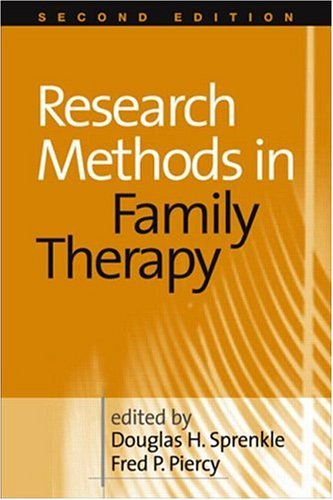One of our main hopes in editing the second edition of Research Methods in Family Therapy is to enhance the status of research in the field, while also making the science of marriage and family therapy (MFT) more accessible to clinicians and students. Over the course of its history, the field of MFT has had an ambivalent relationship with re- search. On the one hand, the early family therapy pioneers considered themselves to be “researchers,” and both Wynne (1983) and Haley (1978) claimed that in the early days there was no distinction between therapists and researchers. Such notables as Lyman Wynne, Murray Bowen, Theodore Litz, Gregory Bateson, Don Jackson, Jay Haley, and others came to family therapy though studying interactional patterns asso- ciated with problem families (Broderick & Schrader, 1981; Sprenkle & Moon, 1996). As the field has developed, it has always had an active (if small) research tradition— and, based on a thorough review of outcome research in the field (Sprenkle, 2002), one could make a case for the claim that some of the effectiveness research in MFT is among the most impressive in the clinical social sciences. On the other hand, one can also make a case that although MFT is now more than 60 years old, the growth of the field has depended more on its intuitive appeal than on solid research evidence for its efficacy (Nichols & Schwartz, 1995). One ex- planation may be that the field’s leaders were often highly charismatic individuals who were less interested in authenticating their claims than in building a following. An- other explanation may be that the master’s degree was established early (1970) as the minimal entry point into the field, and most master’s-degree programs (with notable exceptions) have not offered rigorous research training. As the field grew, it also seemed to attract predominantly practically oriented clinicians who had neither the time nor the inclination for the laborious research enterprise. One study noted that over 80% of the members of the American Association for Marriage and Family Therapy (AAMFT) work in settings that can be considered predominantly clinical (Sprenkle, Bailey, Lyness, Ball, & Mills, 1997).
چکیده فارسی
یکی از امیدهای اصلی ما در ویرایش ویرایش دوم روشهای تحقیق در خانوادهدرمانی، ارتقای جایگاه تحقیقات در این زمینه و در عین حال قابل دسترستر کردن علم ازدواج و خانواده درمانی (MFT) برای پزشکان و دانشجویان است. رشته MFT در طول تاریخ خود رابطه ای دوسوگرا با تحقیق داشته است. از یک طرف، پیشگامان اولیه خانواده درمانی خود را «محقق» می دانستند و وین (1983) و هیلی (1978) هر دو ادعا کردند که در روزهای اولیه هیچ تمایزی بین درمانگران و محققان وجود نداشت. افراد برجسته ای مانند لیمن وین، موری بوون، تئودور لیتز، گریگوری بیتسون، دان جکسون، جی هیلی و دیگران با مطالعه الگوهای تعاملی مرتبط با خانواده های مشکل دار به خانواده درمانی آمدند (برودریک و شریدر، 1981؛ اسپرنکل و مون، 1996). . همانطور که این زمینه توسعه یافته است، همیشه یک سنت تحقیقاتی فعال (اگر کوچک) داشته است - و بر اساس بررسی کامل نتایج تحقیقات در این زمینه (اسپرنکل، 2002)، میتوان این ادعا را مطرح کرد که برخی از تحقیقات اثربخشی در MFT یکی از چشمگیرترین تحقیقات در علوم اجتماعی بالینی است. از سوی دیگر، می توان این مورد را نیز مطرح کرد که اگرچه MFT اکنون بیش از 60 سال از عمر آن می گذرد، رشد این رشته بیشتر به جذابیت شهودی آن بستگی دارد تا شواهد تحقیقاتی محکم برای اثربخشی آن (نیکولز و شوارتز، 1995). یک توضیح ممکن است این باشد که رهبران این رشته اغلب افراد بسیار کاریزماتیکی بودند که کمتر به تأیید ادعاهای خود علاقه داشتند تا دنبال کردن. توضیح دیگر ممکن است این باشد که مدرک کارشناسی ارشد در اوایل (1970) به عنوان حداقل نقطه ورود به این رشته ایجاد شد، و اکثر برنامه های کارشناسی ارشد (به استثنای استثنائات قابل توجه) آموزش تحقیقاتی دقیقی ارائه نکرده اند. همانطور که این رشته رشد کرد، به نظر می رسید که پزشکان عمدتاً دارای گرایش عملی را نیز جذب می کند که نه زمان و نه تمایلی برای کار تحقیقاتی پر زحمت داشتند. یک مطالعه اشاره کرد که بیش از 80 درصد از اعضای انجمن آمریکایی ازدواج و خانواده درمانی (AAMFT) در محیط هایی کار می کنند که می توان آنها را عمدتاً بالینی در نظر گرفت (اسپرنکل، بیلی، لاینس، بال و میلز، 1997).
ادامه ...
بستن ...
Publisher: The Guilford Press, Year: 2005
ISBN: 1572309601,9781572309609
ادامه ...
بستن ...










